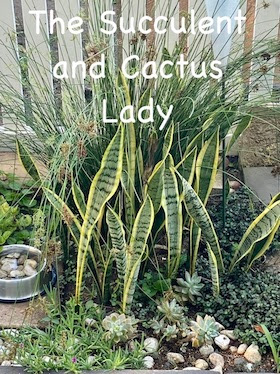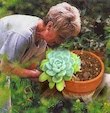Aeonium are without a doubt, some of the most beautiful and sought after additions to succulent collections. They reward our efforts with gorgeous spoon shaped foliage in shades of burgundy and green, sometimes variegated with splashes of palest gold.
In winter I do not remove the dead bottom leaves as they provide protection against the cold
.Aeonium are native to the Canary Islands and North Africa, so you may be able to guess their preferred conditions - warm, or even hot would be the key word.
.
The name means 'evergreen' so this is a plant that never loses its leaves – until after it blooms that is, when the flowering rosette dies. But by then you should have lots of pups to keep this plant going.
Aeonium grow best where minimum temperatures are about 4 degrees Celsius; they can’t take any frost, so a sheltered or indoors environment only for this plant. It requires good ventilation, and bright light – full sun is fine, or partial shade. They prefer a little more moisture in the soil than many other succulent plants. Water as soon as the soil is dry, but don’t allow it to dry too much.
Aeonium in the pot at the back and to the right, in front is Echeveria glauca, which shows the difference between these two species
.Some Aeonium will form a fairly tall stand of rosettes of green, dark burgundy or variegated foliage each on the top of a slender stalk. The leaves are spoon-shaped, sometimes glossy, and occasionally matte.
They can reach a height of a meter (3'), or less than 15cm (5"), depending on the variety. Other species and varieties are suitable for mixed planters and succulent crafts as they tend to be more compact.
Easy to propagate, just remove a rosette with a piece of stem and allow to callous overnight and the stem end can be planted into a pot.
Aeonium - the lovely pink tinges that emerge in winter
Burgundy-tipped Aeonium sharing a pot with an Aloe, some Crassula and a cactus
Aeoniums are members of the Crassulaceae, a huge family of succulents
that include many other popular and commonly grown succulents, including
some that look a lot like Aeoniums. Echeverias in
particular are often confused with Aeoniums and there are several other
rosette-like succulents (eg. Dudleyas, Graptopetalums, Pachyverias and
Graptoverias). One thing that sets t these plants apart is
the way their leaves attach to the stem - they are wrapped around the
stem with a fibrous attachment so that when a leaf is pulled away, the
stem is intact with only a transverse line showing where the leaf was
attached. The other rosette Crassulaceas have succulent attachments and their being pulled off the stem leaves a divot in the stem.










